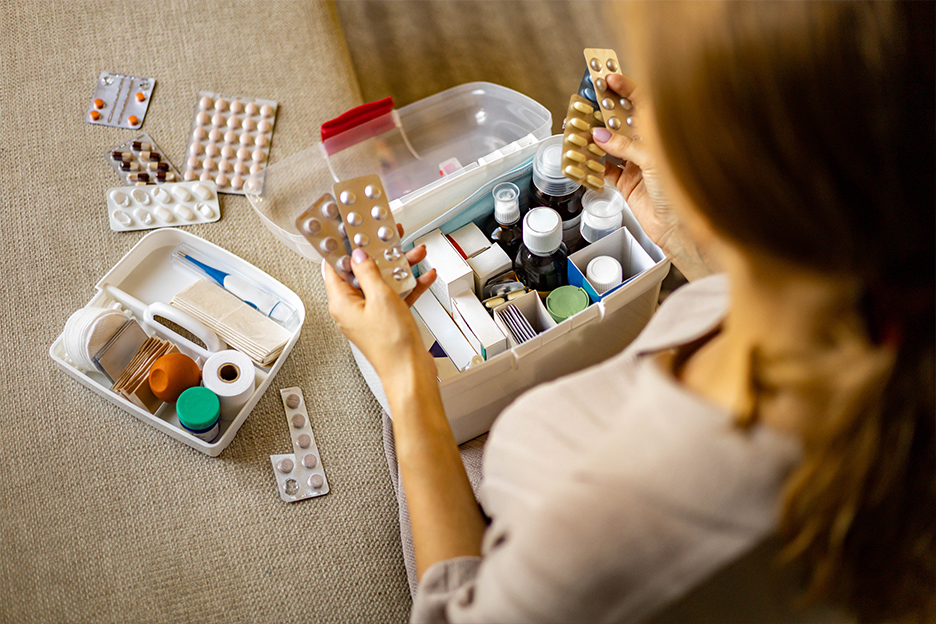Did you know that your home pharmacy should be cleaned out at least twice a year to prevent the risks associated with medication misuse? Many of us don't do it often enough! The next time you're spring-cleaning, take a few minutes to reorganize your medicine cabinet. It'll save you from having to deal with unpleasant surprises! Just follow these four easy steps.

1
Check expiration dates
The first thing to do when cleaning out your medicine cabinet is to get rid of any medications that have passed their expiration date. All prescription and non-prescription drugs and products intended for therapeutic use have an expiration date (natural products included).
Is it dangerous to take expired medication?
Taking expired medication isn't necessarily dangerous, but the product's effectiveness may be altered. It can be risky to take expired medications to treat or control a health problem because their effects will be less than optimal. The main risk is misuse of a medication, and cleaning out your medicine cabinet is a great way to reduce it.
Don't throw out your expired medications!
Once you’ve rounded up the expired products and medications in your medicine cabinet, remember not to throw them in the garbage, sink, or toilet. Instead, take them to your pharmacist, who will send them to a specialized company to be destroyed in a safe and environmentally friendly manner. Your pharmacist can also provide you with a specially designed container to safely store syringes, needles, and any other medical equipment used to administer medications.
Some products, such as antibiotic syrups and eye drops, may be expired even if they haven't passed their expiration date. When in doubt, ask your pharmacist whether these products are still okay to use.
2
Figure out what to keep in your medicine cabinet
Aside from checking expiration dates, cleaning out your medicine cabinet also involves getting rid of any medication that's unsuitable or that you no longer need. To determine whether to hang on to a product, ask yourself the following questions:
- How does this medication affect you? Does it cause any adverse effects?
- Why were you prescribed (or why did you buy) this medication?
- Do you have a medical condition that prevents you from taking this medication?
- What are your doctor's recommendations regarding this medication?
- Does the medication effectively treat your health problems?
- Has the medication changed in appearance, taste, and/or smell?
- What are the side effects of the medication?
- Has the medication been stored properly?
- Do you still need this medication?
Remember that you can always ask your pharmacist to help you answer all these questions and make recommendations based on your needs.
3
Check how your pharmaceutical products are stored
When cleaning out your medicine cabinet, it's very important to verify how your medications are stored. Where and how you store your pharmaceuticals has a direct impact on their quality and effectiveness. Here are some best practices for storing your medications:
- Check the storage instructions for each product in your medicine cabinet. Storage instructions vary by medication. Read the directions on the package of each product to find out the best way to store it.
- Keep your medications out of the reach of children and pets. Ideally, store them in a locked, elevated cabinet. Likewise, make sure all containers have child-resistant caps.
- Protect your medications from freezing, heat, humidity, and light. Places like bathrooms, kitchens, and cars are not appropriate for storing medications, as they are subject to frequent temperature and humidity changes. Instead, choose a cool, dry location out of direct sunlight, such as an overhead cabinet or drawer.
- Keep your medications in their original containers. This makes it easier to have accurate information about a product and use it correctly.
- Avoid mixing medications in the same container. This will keep you from taking the wrong pill. A pill organizer can be useful if you take several medications daily or if you no longer have the original containers.
If there are no recommendations for the temperature at which to store a medication, keep it at room temperature (15°C–30°C) in a spot that's neither hot nor humid. Keep in mind that there is no benefit to refrigerating a product unless otherwise indicated by the manufacturer or a health care professional.
4
Take the opportunity to check the contents of your first-aid kit
When cleaning out your medicine cabinet, you may come across your first-aid kit. When was the last time you checked its contents? Now's a good time to make a list of all those first-aid essentials you might be missing (especially if you have active, fearless children who get a lot of little boo-boos)!
Your first-aid kit should include the following basic items:
- Scissors
- Thermometer
- Tape
- Roll of gauze
- Disposable latex gloves
- Antiseptic wipes
- Hot/cold compress
- Sunburn relief products
- Tweezers, to remove splinters
- Antibiotic ointment or cream
- Compression bandages, in case of sprains
- Alcohol-based hand sanitizer
- Adhesive bandages of various sizes
Depending on you and your family, other products related to specific health problems should be added to your first-aid kit. Examples include an epinephrine injector for severe allergies, an inhaler for anyone with asthma, and fast-acting glucose tablets for diabetics who take insulin.
We also recommend keeping a list of emergency contacts in your first-aid kit. This will save you precious minutes in the event you need to use it.
Have doubts? Questions? Consult your pharmacist!
Visit your Brunet-affiliated pharmacy owner to learn how to manage your medications.
